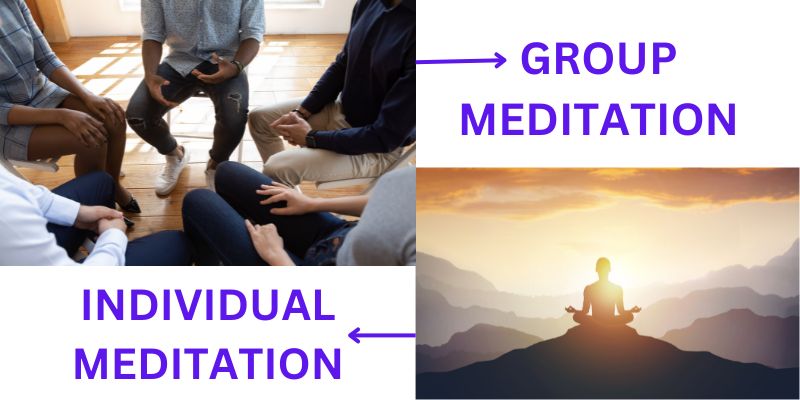Group Meditation Or Individual Practice?
Practicing meditation, whether in groups or individually, offers distinct advantages and disadvantages. Here are some points to consider for each approach:
Advantages of Practicing Meditation in Groups:
- Supportive Environment: Meditating in a group provides a supportive and encouraging environment. Being surrounded by like-minded individuals can foster a sense of community, motivation, and inspiration.
- Accountability: Group meditation sessions often have a structured schedule, which helps individuals commit to a regular practice. The presence of others can create a sense of accountability, making it less likely for individuals to skip or shorten their sessions.
- Shared Energy: Meditating with others can create a collective energy that enhances the overall experience. The combined focus and intention of the group may deepen the meditation practice and facilitate a more profound sense of peace and relaxation.
- Guidance and Instruction: Group meditation sessions are often led by experienced teachers or facilitators who can provide guidance, instruction, and answer questions. This can be particularly helpful for beginners or those seeking to deepen their practice.
Disadvantages of Practicing Meditation in Groups:
- Distractions: Group settings may have external distractions that can hinder concentration and relaxation. Noise, movements, or the presence of unfamiliar people might disrupt the meditative state.
- Compatibility and Comfort: Individuals may have different preferences for meditation styles, techniques, or durations. In a group, there may be limitations on the variety or customization of practices, potentially leading to some discomfort or dissatisfaction.
Advantages of Practicing Meditation Individually:
- Flexibility and Customization: Practicing meditation alone allows for greater flexibility in terms of timing, duration, and technique. Individuals can tailor their practice to their specific needs, preferences, and schedule.
- Privacy and Introspection: Meditating alone offers a private and intimate space for self-reflection, introspection, and self-exploration. There are no external distractions, enabling individuals to dive deeper into their inner experiences.
- Personal Pace: Each person has a unique pace of learning and progress. When practicing individually, individuals can progress at their own speed, without feeling rushed or held back by the group’s dynamics.
Disadvantages of Practicing Meditation Individually:
- Lack of External Support: Without the presence of others, it can be challenging to maintain consistency and motivation in the practice. The absence of a supportive community might make it easier to skip sessions or lose focus.
- Limited Feedback and Guidance: Practicing alone means that there is no immediate feedback or guidance from experienced teachers or fellow practitioners. This might make it harder to address specific challenges or deepen one’s understanding of the practice.
- Potential for Distractions: Being alone during meditation increases the likelihood of being distracted by external factors such as noises, responsibilities, or everyday concerns. Maintaining focus and discipline can be more challenging without the supportive presence of a group.
Ultimately, the choice between practicing meditation in groups or individually depends on personal preference, goals, and circumstances. Some individuals may find a balance between the two approaches by occasionally participating in group sessions for support and guidance while maintaining an individual practice for flexibility and introspection.




